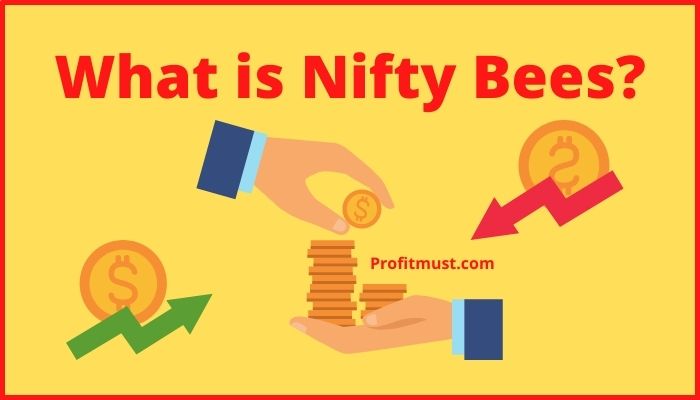When you start taking interest in the stock market, you might encounter many new things instead of stocks. Things like debentures, Nifty bees, Dividends etc are totally new for noob Investors. In this article let’s discuss niftybees meaning and it’s advantages.
Table of Contents
What is Nifty Bees?
The full form of Nifty Bees is Nifty Benchmark Exchange Traded Scheme. It aims to deliver investment returns that closely match the total returns of securities represented by the S&P CNX Nifty Index.
The Nifty BeES is a combo of a share and a mutual fund unit that trades on the NSE‘s capital market section (National Stock Exchange). Every Nifty BeES unit represents a tenth of the value of the S&P CNX Nifty Index.
In the rolling settlement, Nifty BeES units are exchanged and settled in dematerialized form, just like any other stock. As a result, you may trade in real time on the NSE and get real-time symptomatic NAV (net asset value).
Fees and Charges
After Understand What is Nifty bees, Let’s take look at fees and charges. The Nifty BeES approach is a no-load strategy. The annual cost ratio, which includes management fees, is capped at 0.80% of Daily Average Net Assets, one of the cheapest for any mutual fund scheme in India.
For assets worth more than Rs.5 billion, the charges drop to 0.65%. In addition, investing in the Nifty BeEs ETF provides diversity because one unit may be used to invest in 50 different firms.

How does it work?
It was the benchmark’s first ETF, launched in January 2002. Diversification, index tracking, and minimal fees are all advantages of Nifty BeES. Nifty BeES may be purchased and sold like a stock using any NSE terminal at the current market price. Nifty BeES’ basic portfolio closely resembles that of the S&P CNX Nifty.
As a result, Nifty BeES follows the direction of the S&P CNX Nifty & aims to deliver investment returns that closely match the S&P CNX Nifty Index’s total returns on assets.
As they trade on the capital market, Nifty BeEs are extremely liquid. Limit orders can also be placed on these ETFs. Because Nifty BeEs track the S&P CNX Nifty Index, the investor is always up to date on the portfolio.
Value, Face Value & Symbol
Nifty BeEs represent a tenth of the value of the S&P CNX Nifty Index. The face value of the note is INR 10. And with a demat account, investors may simply deal in them.
The units of this ETF may only be bought and sold in a dematerialized manner. Because it is an ETF, the units are bought and sold at the current NAV or market price. This ETF can also be invested in in a systematic manner.
| Base | Code & Symbol |
| ISIN Code | INF732E01011 |
| NSE Symbol | NIFTYBEES |
| Series | EQ |
| Reuters Code | NBES.NS |
| Face Value | 10 |
Advantages of Nifty Bees
After understanding what is Nifty Bees? let’s talk about its advantages. These are some major advantages of Nifty Bees:
-
Easy & Affordable
Buying and selling NiftyBeES is as simple as trading equities securities. Any NSE terminal may be used to purchase and sell at current market prices. Nifty BeES’ underlying portfolio roughly resembles the S&P CNX Nifty.
The NiftyBeES programme is a no-load programme. To put it another way, all costs, such as management fees, do not exceed 0.80% of Daily Average Net Assets.
The cost ratio is one of the cheapest of any mutual fund plan. Moreover, for assets worth more than INR 500 crore, the fees are as small as 0.65%.

-
Holding & Trading
The NiftyBeES is a unit that is traded on the stock exchange (NSE). As a result, it may be purchased at any time throughout the day’s trading hours. Investors might move swiftly to seize an advantage and perhaps place limit orders.
Nifty BeES assets can be held in a DP account with other portfolio assets. The very nature of the Nifty BeES invites liquidity.
Purchasing and selling by investors, arbitrage by authorised players with the actual stocks, and arbitrage using index futures are only a few examples.
As a result of the large transaction volume, the investor has plenty of liquidity.
-
Transparency
This ETF is free of fund management bias. In other sense, the success of these funds is determined by the S&P CNX Nifty Index as well as market demand and supply.
And not on the study and analysis of fund management. Because the Nifty BeES is a replication of the S&P CNX Nifty, unit holders may always see where and how much money is put in a particular stock.
-
Diversified
One unit of the mutual fund provides access to fifty S&P CNX Nifty equities. As a result, it provides a decent risk and diversification spread.
The Nifty BeES features a one-of-a-kind method for purchasing and selling that involves trading a pre-defined portfolio.
Unlike other open ended mutual funds, investors in this long-term fund are not charged for short-term trading. To put it another way, it protects long-term investors from short-term trading.
How to Invest in Nifty BeEs?
Nifty BeES can be purchased via a trading or demat account. Nifty BeES can be purchased in the same way as equity securities (stocks) are. Unit holders can purchase and sell at market prices at any time throughout the trading day.
Moreover, these transactions are subject to brokerage costs comparable to those associated with the purchase of stock securities.
Nifty BeES can be purchased as a single amount or as part of a systematic investment strategy. When investing in a lump sum, investors must purchase units at the current market price.
When markets are cyclically adjusted, lump sum investment is frequently preferred. SIP investing, on the other hand, allows investors to choose a start date for their monthly payments.

Is Niftybees a Good Investment?
Because Nifty BeEs is an ETF, it provides investors with diversity. Because the mutual fund invests in 50 different firms, when traders buy one unit of an ETF, they instantly diversify their portfolio and spread their risk.
The investment portfolio is recognized to the investors since it mimics the S&P CNX Nifty, making it a fairly transparent type of investment. It is traded on the NSE, making it relatively easy to purchase and sell.
Furthermore, Nifty BeEs use an in-kind portfolio construction and redemption method. As a result, long-term investors are protected against trading activity and increased fees incurred by short-term investors.
As a result, they might be regarded as a wise investment.
Do nifty BeEs holders get Dividend?
The scheme’s ability to pay dividends to its investors is based on whether or not it has excess money. Dividend distributions, dividend size, and dividend frequency are frequently decided by the scheme’s trustee.
Dividends are paid to investors after TDS taxes have been deducted. The dividend is generally paid within 30 days of the announcement date. Nevertheless, the amount and timing of dividend distributions are not guaranteed by the fund.
The NAV of the plan will also be lowered by the dividend sum and the dividend distribution tax (DDT) portion after the dividend is paid. Dividends can be paid in a variety of ways, including Cheque, Real-Time Gross Settlement (RTGS) and Electronic Clearing System (ECS).
Is Nifty Bees safe?
The Nifty BeES is a benchmark exchange-traded fund that participates in 50 S&P CNX Nifty firms. The mutual fund is an unpredictable investment because it invests in stocks.
Furthermore, the businesses in which Nifty BeES invests are substantial and reliable. These firms have a proven track record. As a result, the success of Nifty BeES is influenced by the CNX Nifty’s share price.
Moreover, Nifty BeES provides significant portfolio diversification. It’s essential to remember, though, that mutual fund investments are susceptible to market risk. As a result, no returns are guaranteed.
Short Selling in Nifty Bees
Short selling is when an investor sells shares that he or she does not own, such as those borrowed from a brokerage. While short selling is permitted for ETFs, it is not permitted for Nifty BeEs.
ETFS Vs Nifty BeEs
The Nifty BeES is an investment that trades on the NSE‘s capital market segment. It’s a mixture of a stock and a mutual fund component. ETFs, on the other hand, are traded like stocks but with a much reduced fee ratio.
The key distinction is that ETFs can invest in equities, gold, debt, or currency, while Nifty Bees exclusively invests in S&P CNX Nifty funds. So you know what is nifty Bees and how it is diffrent from ETFS.
Conclusion
Investing in an ETF is significantly easier than investing in a stock or a mutual fund that is actively managed. You might also invest in Nifty BeES through a systematic investment plan (SIP).
This is all from our side regarding What is Nifty Bees. Although, if you have any doubts about nifty bees meaning you can just comment below.
Other Interesting blogs related to What is Nifty Bees:
FAQ About What is Niftybees?
Which Nifty BeES is best?
Nippon India ETF Nifty BeES is the best Nifty BeEs.
How Nifty BeES is calculated?
Nifty BeEs represent a tenth of the value of the S&P CNX Nifty Index. The face value of it is INR 10.
Nifty BeES meaning?
Nifty BeES means Benchmark Exchange Traded Scheme.
Nifty BeES zerodha?
Yes, you can invest in Nifty BeES via Zerodha.
how to invest in nifty bees?
Nifty BeES can be purchased and sold at any time during the trading day because it is listed and traded on the NSE. This provides you the ability to respond quickly to industry trends. You can even place limit orders.

